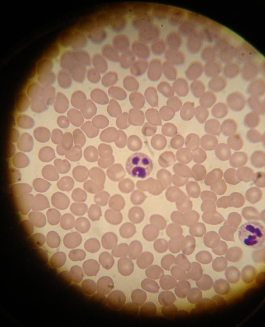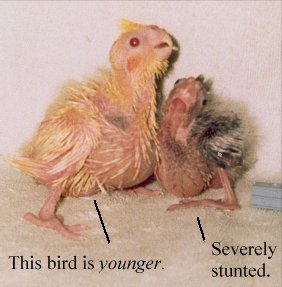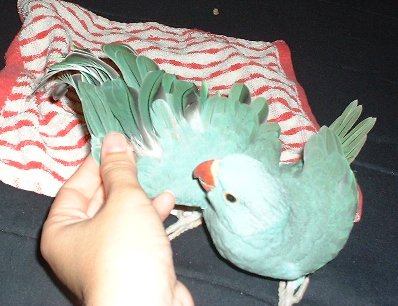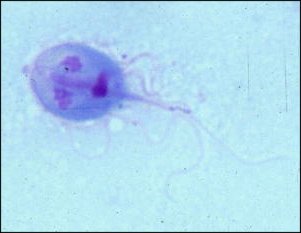 Bacterial Diseases
Bacterial Diseases There are a few definitions you need to be aware of first. You'll see that I refer to some of these diseases as being zoonotic. Zoonotic diseases are those which can be passed between birds and humans. This makes them particularly dangerous. You'll also notice that some diseases are reportable. This means that if the disease is diagnosed you and your veterinarian are legally obligated to inform the government. Diseases are reportable for various reasons, usually because they are either zoonotic and therefore a health hazard to humans, or because they are a major economic threat.
 Bacterial Diseases
Bacterial Diseases
Chlamydia has many names, including parrot fever, psittacosis and ornithosis. It is a zoonotic, reportable disease and is one of the reasons that some states require closed banding of chicks. It is a very common disease most frequently seen in cockatiels and budgies. Most birds will carry the disease without any clinical signs, but these birds can still be infectious. If a carrier of the disease becomes stressed or its immune system compromised, it may become infectious and/or start showing signs of the disease. Clinical signs are run of the mill sick bird symptoms like weight loss and lethargy. Chlamydia is treatable with certain antibiotics.
In humans chlamydia causes flu-like symptoms. If you have such symptoms it is important to inform your doctor that you own birds. Chlamydia is curable but can be fatal if left untreated, particularly in people with weak immune systems.
Tuberculosis (TB) is another bacterial disease that can be zoonotic. It is most commonly seen in Brotogeris. There are several species, some more zoonotic than others. It is frequently transmitted through dust and dander, and can survive for months outside of the body (unless exposed to sunlight). The disease itself may take a long time to begin showing symptoms. In humans, TB usually affects the respiratory system. In birds it generally affects the digestive system. It can cause increased urination, diarrhea, severe weight loss, itchiness, joint aches, masses and enlarged bowels. The body tries to protect itself by walling off the bacteria, forming a small mass called a tubercle. Calcium is then deposited into the tubercle, causing it to harden. These tubercles disrupt normal function wherever they are located- usually under the skin, all inside the digestive tract or in the bone marrow. Some veterinarians recommend that TB birds be euthanized because they are a potential risk to humans. Others prefer to treat the disease, usually with the same medications used for human TB.
Fungal Diseases
 The best prevention against fungal diseases is general cleanliness. There are plenty of disinfectants available on the market to keep spore levels in check. Most fungi thrive in warm, moist environments, so disinfection is particularly important if you live in a humid climate.
The best prevention against fungal diseases is general cleanliness. There are plenty of disinfectants available on the market to keep spore levels in check. Most fungi thrive in warm, moist environments, so disinfection is particularly important if you live in a humid climate.
Candida is a yeast found in all birds on some level, but it generally does not cause problems. Cockatiels in particular are prone to candida infections. Other birds at risk are those being kept on antibiotics and young chicks being handfed. Brooders make an excellent environment for spores to thrive. Reusing formula also greatly increases the risk of infection. The most common symptoms are white spots inside the mouth and a slow crop. Breeders living in humid climates can add small doses of Nystatin to the handfeeding formula as a preventative measure. However, Nystatin is insufficient for more serious cases. Candida can easily be treated by a veterinarian.
Aspergillus is a particularly virulent fungus. Spores exist everywhere in the environment but usually do not cause problems unless a bird is exposed to extremely high numbers of them. Birds with suppressed immune systems, and those kept in crowded, damp, poorly-ventilated cages are more at risk. Higher risk species include African greys and kakarikis. Excessive dust and low humidity can damage the mucosal lining in the lungs making a bird more susceptible. Aspergillus spores are usually inhaled and cause infection in the lungs and air sacs. They can also affect the syrinx, causing the bird's voice to change. Symptoms include difficulty breathing, voice change, lethargy, wheezing, and dramatic weight loss.
Aspergillosis is very difficult to diagnose and even more difficult to treat. Antifungals may be given twice daily for months, and even if a bird recovers it may spontaneously regress a few months later. Surgery may also be required to remove obstructions. In many cases that I have witnessed, the bird's weight actually stays level until it is a few days from death. This was because the fungal masses were so large that they compensated for the weight being lost by the bird.
Viral Diseases Newcastle is a reportable disease that can infect all birds. The disease is airborne but is transmitted more frequently by direct contact or contaminated equipment. Symptoms include neurological problems, diarrhea and sudden death. However, it can take up to a month before infected birds begin to show any clinical signs. Birds smuggled across the border from Mexico are a probable source of the disease in the U.S. Birds that test positive are legally required to be reported and euthanized.
Newcastle is a major threat to the poultry industry, and the CDFA and the USDA have gone to extreme lengths to stamp out the disease. There have been two major outbreaks in the United States- one in the 1970's and one just a few years ago in 2002. In both cases, whole flocks were euthanized to prevent the spread of Newcastle. The 1970's outbreak was directly responsible for the inception of the American Federation of Aviculture to protect owner rights. During the 2002 outbreak, a man living across the street from my aunt in Mira Loma had fighting cocks which tested positive. Every bird within a kilometer radius was euthanized regardless of whether or not they tested positive, including my aunt's flock of lovebirds and chickens. Captive birds were gassed; free-range ones that could not be caught were shot. A few persistent owners in other outbreak locations managed to hold out against depopulation by quarantining themselves from their neighbors.
Newcastle is a poster disease for why breeders need to take quarantine procedures seriously. All it takes is one sick bird to put everyone's flock in jeopardy. During the most recent outbreak, most of us avoided bird marts, disinfected our hands after touching birds, bleached our shoes, etc. How many of us still take any of those precautions? Newcastle is not the only disease that is airborne, nor is it the only one that can travel on clothes and equipment. There are many other diseases that are far more common yet have similarly devastating results.
Once such disease is Psittacine Beak and Feather Disease (PBFD). This virus is also airborne, and can survive for long periods outside of the body, usually on dust or dander. Cockatoos, Indian ringnecks, African greys, macaws, eclectus lovebirds and chicks are most susceptible. The virus only affects psittacines (parrots). In young birds the disease usually causes death. In adult birds the disease tends to cause feather and beak abnormalities. Feathers grow in twisted, fall out completely, or the shaft may contain blood and be pinched and malformed. Lesions may appear on the skin, and the beak may become overgrown, twisted or cracked. Cockatoos, normally very dusty birds, lose their powdery appearance. This is often most notable on the beak, which may turn glossy black. In other species like ringnecks, only specific feathers may be affected. Some birds can survive for years with the disease, though they should always be isolated from other parrots. Like HIV in humans, PBFD affects the immune system, and birds often die of secondary infections. A few birds do manage to fight off the disease immediately after exposure, and then become immune. We are now able to test for PBFD, but there is no vaccine available yet.
Polyomavirus is another disease which can cause feather abnormalities. In budgies it causes the condition known as "French Molt," in which chicks promptly shed their feathers and either die or remain featherless. Symptoms may also include poor coordination, crop stasis and lethargy. Internal hemorrhaging is found in deceased birds. In most species the disease causes death in chicks, which may or may not show clinical signs. Older chicks have a better chance of resisting or recovering from the disease. Adults rarely seem affected, though they can pass polyoma onto both their eggs and chicks. This makes the disease particularly devastating to breeders. The virus can also survive outside of the body indefinitely.
The good news about polyomavirus is that we now have a vaccine for it. Adults are also able to clear themselves of the virus. Given six months to a year, they will clear the infection on their own and become immune.
Pacheco's Disease is caused by a herpesvirus. It causes rapid death of infected birds, usually within a day or two once they show signs. Some infected birds may show no clinical signs and will instead become carriers. These birds can shed the virus at any time, though stress may exacerbate the problem. Treatment with Acyclovir is possible to help prevent death, but it will not cure the bird. Infected birds should be isolated from all but other infected birds. These birds may be bred, but their eggs must be incubator hatched to prevent infection of the chicks. A vaccine is now available.
Pox used to be a problem when parrots were imported, now it is uncommon in psittacines. Canaries are infected by a different type of pox, which does not infect parrots. This disease causes ulcers on the feat, legs and near the beak. It is spread by mosquitos, and netting around aviaries can help prevent an outbreak of the disease. There is also a vaccine available.
West Nile Virus is zoonotic and can affect birds (particularly crows), horses and humans. However, it can only be spread from bird to bird, or bird to human by mosquitos. It cannot be spread from either horses or humans to any other organism. Most humans have no symptoms, though a few have a severe reaction to the virus. It causes neurological problems, such as poor coordination, trembling, stiffness, seizures and headaches. There is a vaccine available to protect horses. This disease is generally a problem of wild birds, not captive psittacines.
Parasitic Diseases 
Scaly-face mites are seen most commonly in budgies. These mites burrow into the skin around the face and legs. Symptoms include feather loss, overgrown beak, crusty face or feet, and a pocketed/pitted appearance around affected areas. Ivermectin is the usual treatment, and can be given by a veterinarian.
Giardia is zoonotic and usually causes diarrhea and weight loss. It affects the lining of the intestines. In cockatiels it frequently causes feather plucking, and the birds may shriek when plucking. Birds usually get it from contaminated water. It can be treated easily, though it may take several treatments to prevent a recurrence.
Roundworms are another intestinal parasite. Transmission of this parasite is highly unlikely unless your birds are kept in aviaries with access to the soil. Even then, it is usually only ground-foraging species that tend to pick up this parasite. Routine deworming may be necessary in this case. Kakarikis and grass parakeets are the common victims.
Diseases of Unknown Cause
Proventricular Dilatation Disease, previously known as Macaw Wasting Syndrome, is thought to be caused by a virus. It causes a general enlargement of the digestive organs, most notably the proventriculus. The proventriculus is a section that occurs between the crop and the gizzard. It is often responsible for secreting enzymes and other digestive juices. Birds with the disease have difficulty digesting food, and may even pass food whole. The disease causes damage by affecting the nerve cells, so poor motor control is also a symptom. Unfortunately, it is difficult to get a clear diagnosis. X-rays may be helpful, but biopsies may further stress the bird or give a false negative. Most birds are only diagnosed for certain after death. It is not known exactly how the disease spreads, though it is considered to be a fairly hardy disease that can last a long time in the environment.
Birds that are diagnosed should be isolated. Parents can pass it onto their chicks, and it is believed that some birds can carry the disease without showing clinical signs. Symptoms may be alleviated in part with a special diet containing large quantities of nutrients and fiber (to ease digestion), and antibiotics (to prevent secondary infections). Treated birds can have their lives extended anywhere from a few months to a year or two. There is currently no cure or vaccine for the disease.
Bibliography
Doane, Bonnie Munro. The Parrot in Health and Illness. New York: Macmillan, 1991.
Gallerstein, Gary A., D.V.M. The Complete Bird Owner's Handbook . New York: Howell Bookhouse, 1994.
McDowell, Ann, D.V.M. Personal Interview. 17 May 2005.
The Merck Veterinary Manual . Merck & Co., Inc. 2003. http://www.merckvetmanual.com/mvm/index.jsp
Purves, William K. et al. Life: The Science of Biology . 7th ed. Gordonsville, Virginia: Sinauer Associates, Inc., 2004.
Sakas, Peter S., D.V.M. Essentials of Avian Medicine . 2nd ed. Lakewood, Colorado: American Animal Hospital Association Press, 2002.
Tully, T. N., M. P. C. Lawton, and G. M. Dorrestein, ed. Avian Medicine . Oxford: Butterworth Heinemann, 2000.
Voren, Howard, and Rick Jordan. Parrots: Handfeeding and Nursery Management . Queensland: Osborne Editions International, 1992.
Go back to Part 1: What causes disease?.

Articles and images contained on this site are © 2005 by Karen Trinkaus unless otherwise noted and may not be reprinted or used in any way without the author's permission.